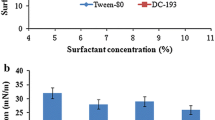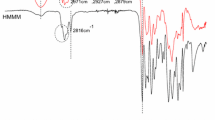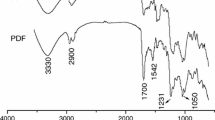Abstract
In this study, polyethylene glycol (PEG) was added to phenol–urea–formaldehyde foam to improve its toughness, and the effects of PEG, with different molecular weights and dosages, on the mechanical property, microstructure, thermal stability, and flame resistance of phenol–urea–formaldehyde foam were studied. The addition of PEG significantly increased the toughness and impact strength and decreased the pulverization rate of the foam. The compression strength of the foam first increased and then decreased with increasing amounts of PEG. When 2 wt% PEGs were added, the compression strength of foams was the highest. The addition of PEG significantly influenced the microstructure of phenol–urea–formaldehyde foams, in which the cell diameter decreased and wall thickness increased with increasing amount and molecular weight of PEG. The addition of PEG also slightly decreased the thermal stability of phenol–urea–formaldehyde foams, and increased the heat release rate, total heat release, and total smoke release of the foams.














Similar content being viewed by others
References
Lei SW, Guo QG, Zhang DQ, Shi JL, Liu L, Wei XH (2010) Preparation and properties of the phenolic foams with controllable nanometer pore structure. J Appl Polym Sci 117:3545–3550
Shen HB, Lavoie AJ, Nutt SR (2003) Enhanced peel resistance of fiber reinforced phenolic foams. Compos Part A 34:941–948
Shen HB, Nutt S (2003) Mechanical characterization of short fiber reinforced phenolic foam. Compos Part A 34:899–906
Rangari VK, Hassan TA, Zhou YX, Mahfuz H, Jeelani S, Prorok BC (2007) Cloisite clay-infused phenolic foam nanocomposites. J Appl Polym Sci 103:308–314
Kaynak C, Cagatay O (2006) Rubber toughening of phenolic resin by using nitrile rubber and amino silane. Polym Test 25(3):296–305
Auad ML, Zhao LH, Shen HB, Nutt SR, Sorathia U (2007) Flammability properties and mechanical performance of epoxy modified phenolic foams. J Appl Polym Sci 104:1399–1407
Horikawa T, Ogawa K, Mizuno K, Hayashi J, Muroyama K (2003) Preparation and characterization of the carbonized material of phenol–formaldehyde resin with addition of various organic substances. Carbon 41:465–472
Wu CS, Lin FY, Chen CY, Chu PP (2006) A polyvinyl alcohol/p-sulfonate phenolic resin composite proton conducting membrane. J Power Sources 160(2):1204–1210
Li WL, Lin Q, Yan MF, Zou YS (2003) Reducing the contents of free phenol and formaldehyde in phenolic foam. J Appl Polym Sci 90(9):2333–2336
Yuan HX, Xing WY, Yang HY, Song L, Hu Y, Yeoh GH (2013) Mechanical and thermal properties of phenolic/glass fiber foam modified with phosphorus-containing polyurethane prepolymer. Polym Int 62(2):273–279
Yang HY, Wang X, Yu B, Yuan HX, Song L, Hu Y, Yuen RKK, Yeoh GH (2013) A novel polyurethane prepolymer as toughening agent: preparation, characterization, and its influence on mechanical and flame retardant properties of phenolic foam. J Appl Polym Sci 128(5):2720–2728
Wang FY, Ma CCM, Wu WJ (2001) Kinetic parameters of thermal degradation of polyethylene glycol-toughened novolac-type phenolic resin. J Appl Polym Sci 80:188–196
İyim TB (2007) Modification of high ortho novolac resin with diacids to improve its mechanical properties. J Appl Polym Sci 106(1):46–52
Choi MH, Byun HY, Chung IJ (2002) The effect of chain length of flexible diacid on morphology and mechanical property of modified phenolic resin. Polymer 43:4437–4444
Zhang YJ,Li XF, And Y, Zhang FH, Zhang YL, Liu T, Dong LH, Yin YS (2013) Polyimide modified phenolic foam, Acta Polym Sin (8):1072–1079
Cardona F, Kin-Tak AL, Fedrigo J (2012) Novel phenolic resins with improved mechanical and toughness properties. J Appl Polym Sci 123(4):2131–2139
Yang HY, Wang X, Yuan HX, Song L, Hu Y, Yuen RKK (2012) Fire performance and mechanical properties of phenolic foams modified by phosphorus-containing polyethers. J Polym Res 19:9831–9840
Sui XY, Wang ZZ (2013) Flame-retardant and mechanical properties of phenolic foams toughened with polyethylene glycol phosphates. Polym Adv Technol 24:593–599
Han ZD, Dong LM, Li Y, Zhao H (2007) A comparative study on the synergistic effect of expandable graphite with APP and IFR in polyethylene. J Fire Sci 25(1):79–91
Acknowledgements
This study was supported by the National Natural Science Foundation of China (Nos. 51304027, 51204103), the State Key Program of coal Joint Funds of National Natural Science Foundation of China (Nos. 51134020, U1261205), Shandong Province Natural Science Foundation (No. ZR2011EL036), Shandong Province High School Science & Technology Fund Planning Project (No. J11LD53), Key technology projects for preventing major accident of National Security State Administration of Work Safety and Shandong Province “Taishan Scholar” Project Fund.
Author information
Authors and Affiliations
Corresponding author
Rights and permissions
About this article
Cite this article
Hu, X.M., Wang, D.M., Cheng, W.M. et al. Effect of polyethylene glycol on the mechanical property, microstructure, thermal stability, and flame resistance of phenol–urea–formaldehyde foams. J Mater Sci 49, 1556–1565 (2014). https://doi.org/10.1007/s10853-013-7838-z
Received:
Accepted:
Published:
Issue Date:
DOI: https://doi.org/10.1007/s10853-013-7838-z




